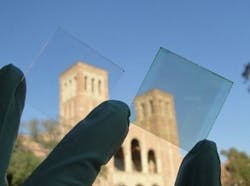Transparent photovoltaic cell from UCLA absorbs and converts IR
Los Angeles, CA--While many somewhat-transparent solar cells for use on windows already exist in experimental form, a new version developed at the University of California, Los Angeles (UCLA) is especially transparent because it converts IR light, rather than a portion of the visible spectrum, to electrical energy.
Made from a photoactive plastic, the polymer solar cell (PSC) is nearly 70% transparent to the human eye; a 4% power-conversion has been achieved. The results of the UCLA research appear in the journal ACS Nano.
The researchers, from the California NanoSystems Institute (CNSI), the UCLA Henry Samueli School of Engineering and Applied Science, and UCLA's Department of Chemistry and Biochemistry, have demonstrated high-performance, solution-processed, visibly transparent polymer solar cells through the incorporation of near-IR light-sensitive polymer and using silver-nanowire/TiO2-nanoparticle composite films as the top transparent electrode.
Polymer photovoltaic cells have attracted great attention due to their advantages over competing solar-cell technologies. Scientists have also been intensely investigating PSCs for their potential in making advances for broader applications.
Previously, many attempts have been made toward demonstrating visibly transparent or semitransparent PSCs. However, these demonstrations often result in low visible light transparency and/or low device efficiency because suitable polymeric PV materials and efficient transparent conductors were not well used in device design and fabrication.
"These results open the potential for visibly transparent polymer solar cells as add-on components of portable electronics, smart windows, and building-integrated photovoltaics and in other applications," said study leader Yang Yang, a UCLA professor of materials science and engineering, who also is director of the Nano Renewable Energy Center at California NanoSystems Institute at UCLA.

John Wallace | Senior Technical Editor (1998-2022)
John Wallace was with Laser Focus World for nearly 25 years, retiring in late June 2022. He obtained a bachelor's degree in mechanical engineering and physics at Rutgers University and a master's in optical engineering at the University of Rochester. Before becoming an editor, John worked as an engineer at RCA, Exxon, Eastman Kodak, and GCA Corporation.
